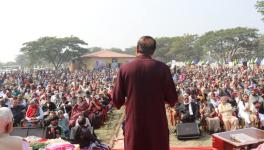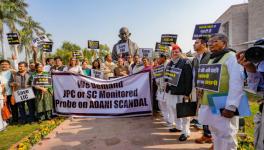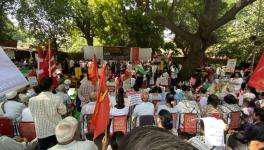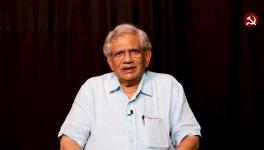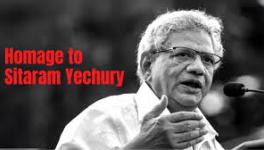G.N. Saibaba – The Teacher I Could Not Have
I saw Professor G.N. Saibaba for the first time at the Delhi University South Campus Cafeteria. I was told that he taught one of our optional papers on Indian Literature, then offered in the third Semester for postgraduate students of the English Department. Although he taught at Ram Lal Anand College, he took classes for postgraduate students as a ‘cooperative’ faculty member. Cooperative faculty members are not paid for their lectures; they are only paid travel allowance. He was teaching us for free, voluntarily taking on more than his load of teaching undergraduate students. I mention these details for a reason. When the word “Maoist” or “Naxalite” gets attached to an individual, our perception of that person undergoes a subtle shift. (Think of the den of anti-national intellectuals housed in Jawaharlal Nehru University.) That Professor Saibaba, in spite of being differently-abled, chose to take more classes without pay, should tell us something about this ‘dangerous’ man, supposedly ready to spew his venom on the nation.
The police, of course, did its best to keep classrooms sanitised. Shortly after the commencement of my third semester, G.N. Saibaba’s house was illegally raided 1 on 12 September, 2013. The police took away his hard disks, pen drives, and personal laptop – electronic devices he had bought and ‘stolen’ at the same time. (The search warrant was for stolen property.) Why did the Maharashtra police stage such a dramatic arrest in Delhi? A report of the arrest, published in the national daily, The Times of India, can provide a clue. It concluded with the claim made by the police that has, so far, not been proved: “Police claimed that besides (Hem) Mishra, three other arrested Maoist leaders, including Kobad Gandhy, Bacha Prasad Singh and Prashant Rahi have also named Saibaba as their contact in the national capital.” While the prosecution referred to Hem Mishra, who is a student, there were no references to the others. Naming more prominent leaders like Ghandy made the public image of Saibaba more sinister. The police wore plain clothes for the same purpose: to give the impression that this was a sensational arrest of an absconding mastermind based in Delhi. The truth is that Saibaba had been cooperating with the police and was regularly in touch with them. 2
Let’s leave the rigmarole of the case behind and go back to the classroom. Why is it important to have teachers like Saibaba? One of his students, Martand Kaushik, writes, “Saibaba viewed literature through a highly political lens. He had completed his PhD thesis on Indian writing in English. The thesis was picked up by a major publisher at the time. Still unpublished, his paper is a damning indictment of most Indian English writers. Highlighting the elite social background of the authors, Saibaba scrutinises the bias in their writings from the perspective of the Indian poor, especially adivasis and lower castes.” I may not agree with Saibaba’s conclusions, but preventing him from teaching in the classroom denies the possibility of these discussions and debate. What is important is that he brought a perspective inside the classroom that challenged what English departments had held dear for many years. In an interview with Hindustan Times, Saibaba compared his situation to the fictional world of Gabriel Garcia Marquez. Many others have called it Kafkaesque. The similarities are not too hard to find. Joseph K., in Franz Kafka’s novel The Trial, discovered that he is arrested for a crime that was never revealed to him. Even though he was under arrest, he was not kept in confinement. As a result, he found himself jailed psychologically even as he moved around freely. In Saibaba’s situation too, the trail was as much a test on his psychological health, as it was a test of his physical endurance.
Saibaba’s failing health condition had been a concern already as the trial went underway. The concern was shared not just by the Defence Committee or his family members and well-wishers, but also by the National Human Rights Commission (NHRC), which sent notices to the Secretary of the Prison Administration of the Government of Maharashtra, and to the Superintendent of the Central Jail in Nagpur. The judgement, however, does not share the concerns of the NHRC:
Hence, merely because the accused no.6 Saibaba is 90% disabled is no ground to show him leniency and though he is physically handicapped but he is mentally fit and he is a think tank and high profile leader of banned organization CPI (Maoist) and its frontal organization RDF and by the violent activities of accused nos.1 to 6 and members of banned organization CPI (Maoist) and its frontal organization RDF, the situation of Gadchiroli district from 1982 till today is in paralyzed condition and no industrial and other developments are taking place because of fear of naxal and their violent activities. Hence, in my opinion, the imprisonment for life is also not a sufficient punishment to the accused but the hands of the Court are closed with the mandate of Section 18 and 20 of UAPA and in my opinion it is a fit case to award sentence of imprisonment of life to accused no.1 Mahesh Tirki, no.2 Pandu Narote, no.3 Hem Mishra, no.4 Prashant Rahi and no.6 Saibaba for offence… (emphasis mine)
The judgement came as a huge blow, and the distress was evident in the faces of those who came for the Press Conference organised by the Defence Committee on 20 April, 2017. The critique of the judgement brought out by the Defence Committee — When the Prosecution’s Case Becomes the Judge’s Onus — has cited loopholes in the evidence that links Saibaba to the Revolutionary Democratic Front (RDF), and the organisation’s link with the Communist Party of India (Maoist), but even if we accept the association, he is still charged for vague, and not specific, crimes committed by “naxals”. Markanday Katju, former judge of the Supreme Court, has said: “The case against Saibaba is that he had links with Maoist extremists. However, in Sri Indra Das vs. State of Assam, 2011. the Supreme Court observed that mere membership of a banned organisation (i.e. banned under the Unlawful Activities Prevention Act or TADA or any other statute) will not incriminate a person.” If we keep this in mind, the biases operating in the judgement are clear.
Saibaba and the others are held guilty for preventing the industrial development of Gadchiroli district from 1982. In the press conference held by the Defence Committee, Vasantha Kumari, Saibaba’s wife, had said, “This is a democratic, secular country. We will have different opinions on different matters. If you impose one idea over other ideas, we will not accept it… This jal, jangal, jameen is ours. It is our right.” According to the judgement, Saibaba is held guilty for holding opinions on development that the state of Maharashtra does not agree with. He is, to quote the more management term of the judgement, a “think tank”. These tanks are full, and there are too many of them, sprouting out of dense jangals, preventing the spread of the industrialised, developmental tanks of the state. The resoluteness of every person present in the press conference is proof that these tanks will brim with taste of jal, the canopy of the jangal, and smell of jameen.
Disclaimer: The views expressed here are the author's personal views, and do not necessarily represent the views of Newsclick
Get the latest reports & analysis with people's perspective on Protests, movements & deep analytical videos, discussions of the current affairs in your Telegram app. Subscribe to NewsClick's Telegram channel & get Real-Time updates on stories, as they get published on our website.









